Twice as many men as women commute by bike in Minneapolis-St. Paul, and the likely reasons are varied.

Greta Kaul writes that data shows the Twin Cities has one of the highest levels of bike commuting in the country, but it also has a gender gap in cycling. "In the Minneapolis-St. Paul metro area, men who work were twice as likely to commute via bike as women who work, at 1.2 percent, compared to 0.6 percent."
While this gap is smaller than it is in most other U.S. cities, men still commute by bike more than women generally. The reasons for this difference include women’s concerns about safety, the perceived need to be "put together" at work, and the greater responsibility put on women to transport children.
While Minneapolis-St. Paul is relatively bike-friendly, the gender gap suggests that changes still need to be made to bring more women into cycling. Kaul notes that safer streets would encourage women to bike as well bike shops that make biking accessible to women and other underrepresented groups. "The gender gap isn’t the only gap activists are working to close in biking in Minnesota, said [Linnea] House, of Move Minnesota. There are also gaps for people of color and seniors, she said."

Alabama: Trump Terminates Settlements for Black Communities Harmed By Raw Sewage
Trump deemed the landmark civil rights agreement “illegal DEI and environmental justice policy.”

Planetizen Federal Action Tracker
A weekly monitor of how Trump’s orders and actions are impacting planners and planning in America.

The 120 Year Old Tiny Home Villages That Sheltered San Francisco’s Earthquake Refugees
More than a century ago, San Francisco mobilized to house thousands of residents displaced by the 1906 earthquake. Could their strategy offer a model for the present?

In Both Crashes and Crime, Public Transportation is Far Safer than Driving
Contrary to popular assumptions, public transportation has far lower crash and crime rates than automobile travel. For safer communities, improve and encourage transit travel.

Report: Zoning Reforms Should Complement Nashville’s Ambitious Transit Plan
Without reform, restrictive zoning codes will limit the impact of the city’s planned transit expansion and could exclude some of the residents who depend on transit the most.

Judge Orders Release of Frozen IRA, IIJA Funding
The decision is a victory for environmental groups who charged that freezing funds for critical infrastructure and disaster response programs caused “real and irreparable harm” to communities.
Urban Design for Planners 1: Software Tools
This six-course series explores essential urban design concepts using open source software and equips planners with the tools they need to participate fully in the urban design process.
Planning for Universal Design
Learn the tools for implementing Universal Design in planning regulations.
Clanton & Associates, Inc.
Jessamine County Fiscal Court
Institute for Housing and Urban Development Studies (IHS)
City of Grandview
Harvard GSD Executive Education
Toledo-Lucas County Plan Commissions
Salt Lake City
NYU Wagner Graduate School of Public Service





























